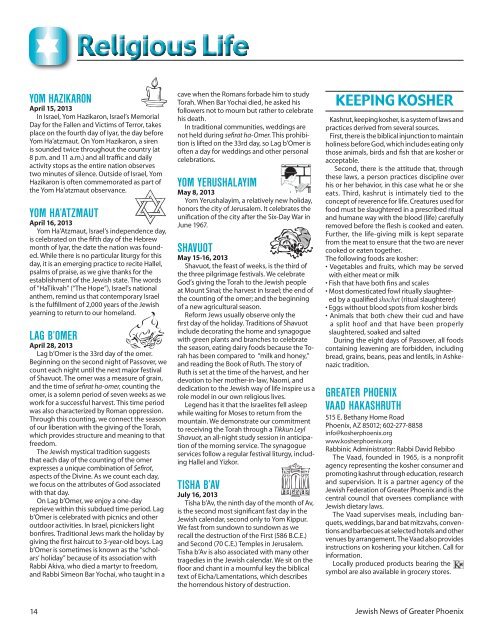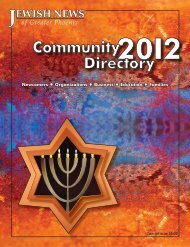downloadable PDF - Jewish News of Greater Phoenix
downloadable PDF - Jewish News of Greater Phoenix
downloadable PDF - Jewish News of Greater Phoenix
You also want an ePaper? Increase the reach of your titles
YUMPU automatically turns print PDFs into web optimized ePapers that Google loves.
ì<br />
14<br />
Religious Life<br />
YOM HAZIKARON<br />
April 15, 2013<br />
In Israel, Yom Hazikaron, Israel’s Memorial<br />
Day for the Fallen and Victims <strong>of</strong> Terror, takes<br />
place on the fourth day <strong>of</strong> Iyar, the day before<br />
Yom Ha’atzmaut. On Yom Hazikaron, a siren<br />
is sounded twice throughout the country (at<br />
8 p.m. and 11 a.m.) and all traffic and daily<br />
activity stops as the entire nation observes<br />
two minutes <strong>of</strong> silence. Outside <strong>of</strong> Israel, Yom<br />
Hazikaron is <strong>of</strong>ten commemorated as part <strong>of</strong><br />
the Yom Ha’atzmaut observance.<br />
YOM HA’ATZMAUT<br />
April 16, 2013<br />
Yom Ha’Atzmaut, Israel’s independence day,<br />
is celebrated on the fifth day <strong>of</strong> the Hebrew<br />
month <strong>of</strong> Iyar, the date the nation was founded.<br />
While there is no particular liturgy for this<br />
day, it is an emerging practice to recite Hallel,<br />
psalms <strong>of</strong> praise, as we give thanks for the<br />
establishment <strong>of</strong> the <strong>Jewish</strong> state. The words<br />
<strong>of</strong> “HaTikvah” (“The Hope”), Israel’s national<br />
anthem, remind us that contemporary Israel<br />
is the fulfillment <strong>of</strong> 2,000 years <strong>of</strong> the <strong>Jewish</strong><br />
yearning to return to our homeland.<br />
LAG B’OMER<br />
April 28, 2013<br />
Lag b’Omer is the 33rd day <strong>of</strong> the omer.<br />
Beginning on the second night <strong>of</strong> Passover, we<br />
count each night until the next major festival<br />
<strong>of</strong> Shavuot. The omer was a measure <strong>of</strong> grain,<br />
and the time <strong>of</strong> sefirat ha-omer, counting the<br />
omer, is a solemn period <strong>of</strong> seven weeks as we<br />
work for a successful harvest. This time period<br />
was also characterized by Roman oppression.<br />
Through this counting, we connect the season<br />
<strong>of</strong> our liberation with the giving <strong>of</strong> the Torah,<br />
which provides structure and meaning to that<br />
freedom.<br />
The <strong>Jewish</strong> mystical tradition suggests<br />
that each day <strong>of</strong> the counting <strong>of</strong> the omer<br />
expresses a unique combination <strong>of</strong> Sefirot,<br />
aspects <strong>of</strong> the Divine. As we count each day,<br />
we focus on the attributes <strong>of</strong> God associated<br />
with that day.<br />
On Lag b’Omer, we enjoy a one-day<br />
reprieve within this subdued time period. Lag<br />
b’Omer is celebrated with picnics and other<br />
outdoor activities. In Israel, picnickers light<br />
bonfires. Traditional Jews mark the holiday by<br />
giving the first haircut to 3-year-old boys. Lag<br />
b’Omer is sometimes is known as the “scholars’<br />
holiday” because <strong>of</strong> its association with<br />
Rabbi Akiva, who died a martyr to freedom,<br />
and Rabbi Simeon Bar Yochai, who taught in a<br />
cave when the Romans forbade him to study<br />
Torah. When Bar Yochai died, he asked his<br />
followers not to mourn but rather to celebrate<br />
his death.<br />
In traditional communities, weddings are<br />
not held during sefirat ha-Omer. This prohibition<br />
is lifted on the 33rd day, so Lag b’Omer is<br />
<strong>of</strong>ten a day for weddings and other personal<br />
celebrations.<br />
YOM YERUSHALAYIM<br />
May 8, 2013<br />
Yom Yerushalayim, a relatively new holiday,<br />
honors the city <strong>of</strong> Jerusalem. It celebrates the<br />
unification <strong>of</strong> the city after the Six-Day War in<br />
June 1967.<br />
SHAVUOT<br />
May 15-16, 2013<br />
Shavuot, the feast <strong>of</strong> weeks, is the third <strong>of</strong><br />
the three pilgrimage festivals. We celebrate<br />
God’s giving the Torah to the <strong>Jewish</strong> people<br />
at Mount Sinai; the harvest in Israel; the end <strong>of</strong><br />
the counting <strong>of</strong> the omer; and the beginning<br />
<strong>of</strong> a new agricultural season.<br />
Reform Jews usually observe only the<br />
first day <strong>of</strong> the holiday. Traditions <strong>of</strong> Shavuot<br />
include decorating the home and synagogue<br />
with green plants and branches to celebrate<br />
the season, eating dairy foods because the Torah<br />
has been compared to “milk and honey,”<br />
and reading the Book <strong>of</strong> Ruth. The story <strong>of</strong><br />
Ruth is set at the time <strong>of</strong> the harvest, and her<br />
devotion to her mother-in-law, Naomi, and<br />
dedication to the <strong>Jewish</strong> way <strong>of</strong> life inspire us a<br />
role model in our own religious lives.<br />
Legend has it that the Israelites fell asleep<br />
while waiting for Moses to return from the<br />
mountain. We demonstrate our commitment<br />
to receiving the Torah through a Tikkun Leyl<br />
Shavuot, an all-night study session in anticipation<br />
<strong>of</strong> the morning service. The synagogue<br />
services follow a regular festival liturgy, including<br />
Hallel and Yizkor.<br />
TISHA B’AV<br />
July 16, 2013<br />
Tisha b’Av, the ninth day <strong>of</strong> the month <strong>of</strong> Av,<br />
is the second most significant fast day in the<br />
<strong>Jewish</strong> calendar, second only to Yom Kippur.<br />
We fast from sundown to sundown as we<br />
recall the destruction <strong>of</strong> the First (586 B.C.E.)<br />
and Second (70 C.E.) Temples in Jerusalem.<br />
Tisha b’Av is also associated with many other<br />
tragedies in the <strong>Jewish</strong> calendar. We sit on the<br />
floor and chant in a mournful key the biblical<br />
text <strong>of</strong> Eicha/Lamentations, which describes<br />
the horrendous history <strong>of</strong> destruction.<br />
kEEpIng kOSHEr<br />
Kashrut, keeping kosher, is a system <strong>of</strong> laws and<br />
practices derived from several sources.<br />
First, there is the biblical injunction to maintain<br />
holiness before God, which includes eating only<br />
those animals, birds and fish that are kosher or<br />
acceptable.<br />
Second, there is the attitude that, through<br />
these laws, a person practices discipline over<br />
his or her behavior, in this case what he or she<br />
eats. Third, kashrut is intimately tied to the<br />
concept <strong>of</strong> reverence for life. Creatures used for<br />
food must be slaughtered in a prescribed ritual<br />
and humane way with the blood (life) carefully<br />
removed before the flesh is cooked and eaten.<br />
Further, the life-giving milk is kept separate<br />
from the meat to ensure that the two are never<br />
cooked or eaten together.<br />
The following foods are kosher:<br />
• Vegetables and fruits, which may be served<br />
• with either meat or milk<br />
• Fish that have both fins and scales<br />
• Most domesticated fowl ritually slaughter-<br />
• ed by a qualified shochet (ritual slaughterer)<br />
• Eggs without blood spots from kosher birds<br />
• Animals that both chew their cud and have<br />
• a split ho<strong>of</strong> and that have been properly<br />
• slaughtered, soaked and salted<br />
During the eight days <strong>of</strong> Passover, all foods<br />
containing leavening are forbidden, including<br />
bread, grains, beans, peas and lentils, in Ashkenazic<br />
tradition.<br />
GREATER PHOENIx<br />
VAAd HAKASHRUTH<br />
515 E. Bethany Home Road<br />
<strong>Phoenix</strong>, AZ 85012; 602-277-8858<br />
info@kosherphoenix.org<br />
www.kosherphoenix.org<br />
Rabbinic Administrator: Rabbi David Rebibo<br />
The Vaad, founded in 1965, is a nonpr<strong>of</strong>it<br />
agency representing the kosher consumer and<br />
promoting kashrut through education, research<br />
and supervision. It is a partner agency <strong>of</strong> the<br />
<strong>Jewish</strong> Federation <strong>of</strong> <strong>Greater</strong> <strong>Phoenix</strong> and is the<br />
central council that oversees compliance with<br />
<strong>Jewish</strong> dietary laws.<br />
The Vaad supervises meals, including banquets,<br />
weddings, bar and bat mitzvahs, conventions<br />
and barbecues at selected hotels and other<br />
venues by arrangement. The Vaad also provides<br />
instructions on koshering your kitchen. Call for<br />
information.<br />
Locally produced products bearing the<br />
symbol are also available in grocery stores.<br />
<strong>Jewish</strong> <strong>News</strong> <strong>of</strong> <strong>Greater</strong> <strong>Phoenix</strong>



